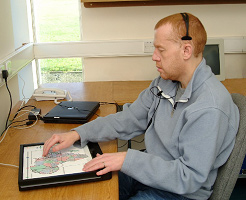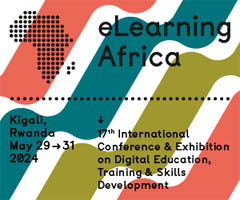What If You Can't See the Computer Screen?
 Hereford (UK)/ Dublin (IRL)/ Graz (AU)/ Hellrup (DK)/ Pavia (I)/ Bucharest (RO), February 2007 - There are some 450+ million people in the EU. Depending on the source, the number of people categorized as blind or visually impaired varies from around 1.5% to 4% of the population, depending on age, ethic grouping, etc. Taking a conservative 2% as a reasonable average, this means there are approximately nine million people who have some level of visual impairment. These individuals, of course, are entitled to equality of access to information, education, and training.
Hereford (UK)/ Dublin (IRL)/ Graz (AU)/ Hellrup (DK)/ Pavia (I)/ Bucharest (RO), February 2007 - There are some 450+ million people in the EU. Depending on the source, the number of people categorized as blind or visually impaired varies from around 1.5% to 4% of the population, depending on age, ethic grouping, etc. Taking a conservative 2% as a reasonable average, this means there are approximately nine million people who have some level of visual impairment. These individuals, of course, are entitled to equality of access to information, education, and training.
Digital networks are making the world shrink. The opportunities offered by the Internet to create -˜global e-classrooms' in which people can communicate and be educated without leaving their work area seems set to launch an -˜education revolution' that could dwarf the -˜industrial revolution' in its effect on the way people live. The full potential of using web communities in education has yet to be fully explored, but one thing will remain: practically every academic or vocational subject taught contains a varying degree of graphical data - maps, diagrams, charts, graphs, or pictures.
These are easy to see on a computer screen for those with sight but present an insurmountable obstacle to those without.
The conversion of these visual images into traditional tactile diagram formats opens the door to accessibility and inclusion. However, in the past, this has always required the assistance - usually on a one to one basis - of a trainer to explain the tactile diagram or the addition of voluminous Braille notations. That may be possible in a conventional classroom, but something different has to be done for an e-classroom.
The subjects may be diverse:
- Business studies use pie charts, bar charts, organisation charts, process and flow diagrams, office plans, computer usage, screen layouts for MS Word or Excel, etc.
- Biology is a subject with enormous graphic content, including illustrations of muscle groups, skeletal structure, cell structure, circulation systems, lymphatic system, nervous system, and so on.
- Physics depicts molecular structure, principles of levers and moments, cantilevers, pulleys and mechanical advantage diagrams, and many other objects and concepts.
Considering the growing range of subjects that can be taught via eLearning, the problem is compounded considerably.
The amount of information contained in a normal tactile sheet is limited for a number of reasons:
- It is only possible to use a small number of textures due to the limitations of the human fingers' ability to distinguish between them.
- Due to the size of tactile graphics, only a small amount of Braille can be entered on each sheet. Large amounts tend to make the tactile graphics difficult to read, and sometimes the users have to read all the explaining text on a different sheet, causing even greater assimilation difficulties.
- If the user is not a Braille reader, other significant problems arise.
The report "Why accessible e-learning makes business sense" issued by the UK CIPD (Chartered Institute of Personnel and Development) in January 2005 mentions that a recent CEDEFOP survey revealed that 55% of respondents agreed that eLearning would open up new learning opportunities for learners with disabilities. Furthermore, 80% of trainers stated that eLearning should be provided to learners with disabilities to improve access to learning.
Margaret Bordogna-Crane, a researcher with The British Council of Disabled People, observes in the report that many disabled people have been excluded from education. She adds that the problem is compounded by the fact that some come to believe, 'It's my fault' 'I'm stupid' or say, 'I don't want to draw attention to myself', and thus perpetuate the problems by excluding themselves.
The report goes on to state "Unlike classroom based learning, eLearning offers a new option untainted by previous experience that might be more appealing to disabled learners than traditional educational methods".
Most eLearning training courses, however, still require access to diagrammatic, graphic, or cartographic imagery. For the sighted, this presents no problem, but for the unsighted, it is simply not achievable. Braille can only cope with alpha/numeric formats; screen readers offer only limited descriptions of on-screen images that cannot be experienced in any suitable format for the visually impaired or blind.
The Socrates MINERVA project, led by The Royal National College for the Blind in Hereford, UK with partners in Ireland, Austria, Denmark, Italy, and Romania, is developing an innovative method of communicating visual graphics (maps, diagrams, graphs and charts, pictures, etc.) in a manner that can be assimilated for people with a visual impairment who are learning at a distance.
The title of the project - AHVITED stands for Audio Haptics for Visually Impaired Training and Education at a Distance.
The core theme of the project is to deliver graphic-intensive elearning course-content material by sound and touch through the medium of "Talking Tactile Technology". This is a tactile diagram with raised lines, textures, and infills that be can be explored by finger touch in a manner similar to Braille. The innovation in talking tactiles is the addition of merged audio files to explain and inform the user of the content of the tactile diagram.
Most known eLearning programmes for the blind or visually impaired tend to use screen reader technology, with its inherent limitations. AHVITED Talking Tactiles will supplement existing eLearning processes to support web-based e-learning materials and provide total autonomy of use in a distance-learning environment.
Operation is simplicity itself, a laptop-sized, touch-sensitive device is connected to a standard computer via a USB connection, and the program CD is inserted. To activate the system, all that is needed is a talking tactile diagram that is placed on the surface of the device and touched by the operator's finger.
Depending on the CD or e-programme content, the operator now has access to a huge volume of information and data on any pre-selected subject by moving around the surface area and applying touch pressure. The linked audio file then recites the relevant information or tutorial corresponding to the selected point or area.
The pedagogical processes being developed by this system are innovative and will bring accessibility and inclusion to new levels. They can easily be assimilated into existing curriculum processes and content as they are essentially based on the application/adaptation of visual graphics in common usage across the EU in each relevant subject area. AHVITED will create a simple resource tool that has huge potential to solve previously unsolvable problems in the interpretation of visual graphics by the visually impaired or blind studying in a distance or remote eLearning situation.
All education and training providers will be able to supplement their existing materials with AHVITED materials to support this sector group. Production of the talking tactile materials can be carried out within the provider's resource centre for little in the way of additional equipment.
The prime output from the AHVITED project will be a methodology of delivering visual images in a non-visual format that is touch-and-sound based for use in the education and training of people with a visual impairment. This project will be specifically directed at supporting such individuals in a distance-learning environment.
- The project will produce three sets of pilot or sample lesson content materials for use as proof of concept.
- The research report will offer findings, evaluation, and analysis of the problems of teaching / training visually impaired people in a distance-learning environment.
- The project website will give the project objectives and findings and will provide specific advice to distance-learning providers on the benefits of this new teaching system. It will also explain how they can create their own adaptive programmes for our target group.
- Through the website and supporting paper documentation, a set of common standards and guidelines for the design and production of talking tactile materials to promote trans-national standardisation will be produced.









